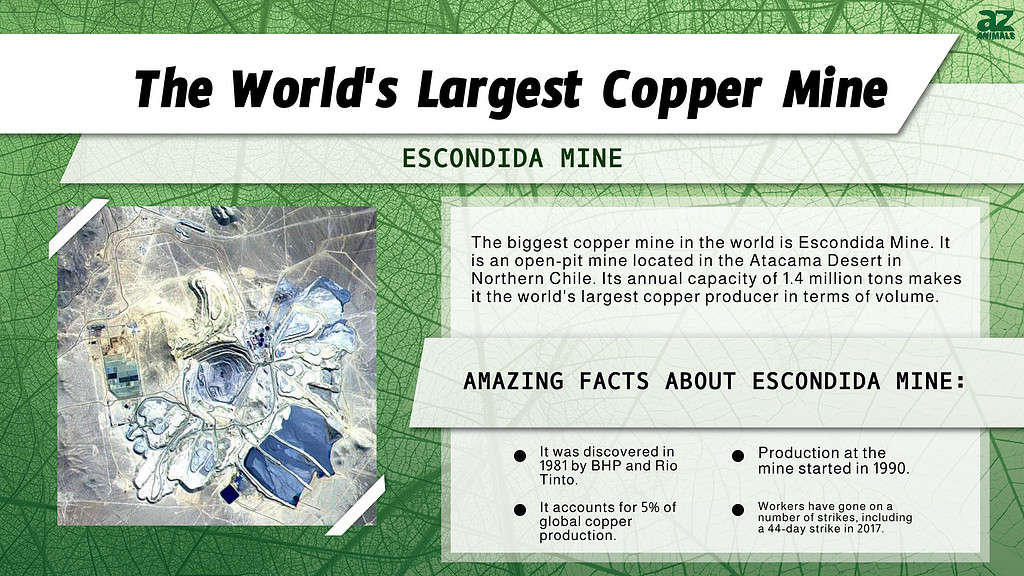Key Points:
- The Escondida Mine in Chile was discovered in 1981 by BHP and Rio Tinto.
- Production at the mine began in 1990, and it has a rich history since then.
- The Escondida Mine is currently the world’s largest copper mine, contributing to about 5% of global copper production.
Copper is a valuable and versatile metal. It has been in use for thousands of years in a wide range of applications, from electrical wiring to construction to transportation. As a result, copper mines are found all over the world.
With so many copper mines scattered across the globe, it can be difficult to determine which one is the largest. However, by examining the production capacity of various mines, we uncovered the answer to this question. Learn more about the global copper industry and find out which copper mine is the biggest!
The largest copper mine in the world is the Escondida Mine in Chile. It is an open-pit mine and has an annual capacity of 1.4 million tons. This makes it the world’s largest copper producer in terms of volume. The mine is owned by BHP and is located in the Atacama Desert in Northern Chile.
Open-pit mining is a common method for extracting minerals like copper. The process typically involves the removal of large amounts of rock and soil to uncover the mineral deposit. The extracted material is then transported to a processing plant, where it is processed to extract the desired mineral.

History of the Escondida Mine in Chile
The Escondida Mine in Chile has a rich history. It was discovered in 1981 by a joint venture between BHP and Rio Tinto, with production starting in 1990. Since then, Escondida has become the largest copper mine in the world, accounting for approximately 5% of global copper production.
The mine has experienced a number of strikes over the years, most notably in 2017. Workers walked out for 44 days in what became the longest private-sector mining strike in Chilean history. Despite these challenges, Escondida remains a major contributor to the Chilean and global economies. It continues to play an important role in the copper mining industry.
Copper Mining in Chile
Chile is the world’s top producer of copper, accounting for 28% of global production. Copper mining is a significant part of the Chilean economy and a major contributor to government revenue. Approximately 80% of Chilean copper production comes from porphyry copper deposits. These are large-scale projects that involve the extraction of copper from low-grade ores using open-pit mining methods.
Other large copper mines in Chile include the Chuquicamata Mine, the Collahuasi Mine, and the El Teniente Mine.
Benefits
The copper mining sector in Chile is responsible for direct employment for thousands of people. It also contributes to indirect employment opportunities throughout the economy. It has played an important role in the development of local communities through investments in infrastructure, education, and social programs. The mine has also contributed to the development of Chilean mining technology and innovation. It has paved the way for further advancements in the industry.

Puerto Colosois, an alternative to the port of Antofagasta, serves mining shipments from Escondida Mine.
©Jose Luis Stephens/Shutterstock.com
Challenges
Despite being a major player in the global copper industry, copper mining in Chile is not without its challenges. The industry has faced criticism from environmental groups for the impacts of open pit mining on the landscape. They are also criticized for the use of large amounts of water in the mining process. Additionally, labor disputes and political instability have at times disrupted mining operations.
Chilean copper mining faces challenges related to sustainability, transparency, and governance. However, the industry continues to play an important role in the country’s development and global markets.
Where Is the Escondida Mine Located on a Map?
The Escondida copper-gold-silver mine is located in Chile’s Atacama Desert, just south-east of the port of Antofagasta.
Here is the Escondida Mine on a map:
In Conclusion
In conclusion, the mining industry in Chile plays a vital role in the country’s economic development. As the world’s top producer of copper, Chile is a major supplier of this important metal to the global market. The Escondida Mine is a key player in this industry and is the largest copper mine in the world. Despite facing environmental and labor challenges over the years, Escondida continues to be a major source of direct and indirect employment opportunities in the region and a significant contributor to Chile’s economy.
Given its economic importance and contribution to global markets, the mining industry in Chile and the Escondida Mine specifically will continue to play a significant role in the country’s future. However, it is important that the industry continues to address sustainability and labor issues while improving transparency and accountable governance, in order to ensure that mining in Chile remains responsible and sustainable for decades to come.
The photo featured at the top of this post is © NASA - The original uploader was Seth Ilys at English Wikipedia / Public domain, via Wikimedia Commons – License / Original
Thank you for reading! Have some feedback for us? Contact the AZ Animals editorial team.






